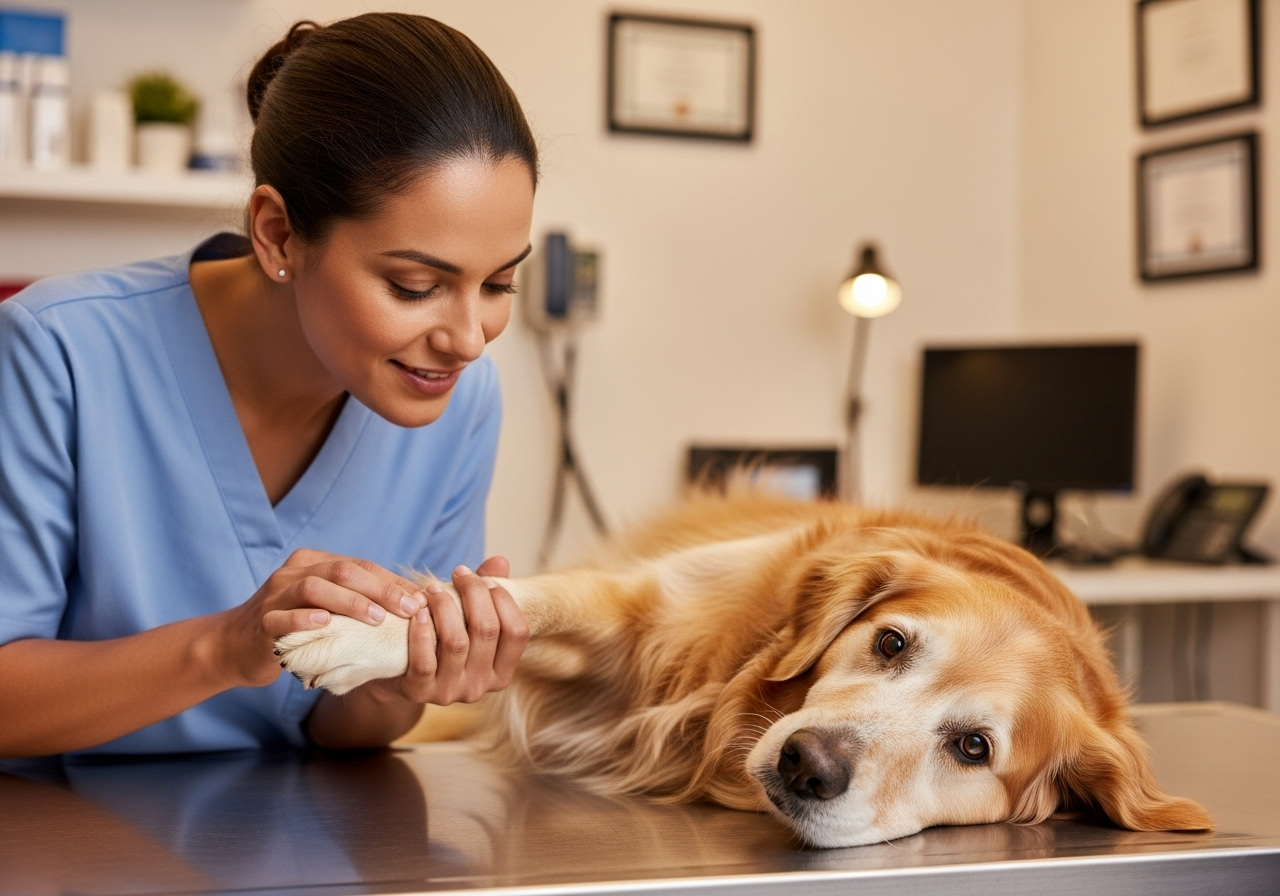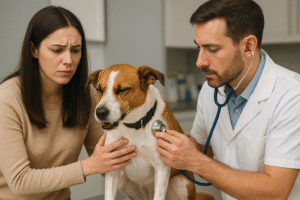Medical Disclaimer: This article is for informational purposes only and is not a substitute for professional veterinary advice, diagnosis, or treatment. Always seek the advice of your veterinarian with any questions you may have regarding your dog’s medical condition.
Table of Contents
Hearing the word “cancer” in the same sentence as your beloved dog is a moment that can make your world stand still. As a veterinarian in Ottawa for over eight years, I’ve shared this difficult conversation with many pet owners. Your first thoughts are likely a whirlwind of fear and questions.
My goal is to clear away some of that uncertainty and walk you through how we, as veterinarians, diagnose cancer in dogs.
Key Takeaways: Understanding the Diagnostic Journey
- It Starts with a Conversation: Your observations are vital. The process always begins with a detailed discussion and a thorough hands-on physical exam, where we search for subtle clues.
- Seeing is Believing: Diagnostic imaging, like x-rays and ultrasounds, allows us to look inside your dog’s body to find, measure, and evaluate suspicious areas non-invasively.
- The Definitive Answer: While imaging can raise suspicion, a biopsy or cytology (cell sample) is almost always needed to get a definitive diagnosis. This tells us exactly what we are dealing with.
- The Future is Here: Exciting new blood tests, called liquid biopsies, are emerging as a powerful tool to help us diagnose cancer in dogs earlier than ever before.
The Starting Point: A Thorough Consultation and Physical Exam
You can also visit: https://doglifeexpert.com/heartworm-prevention-for-dogs/
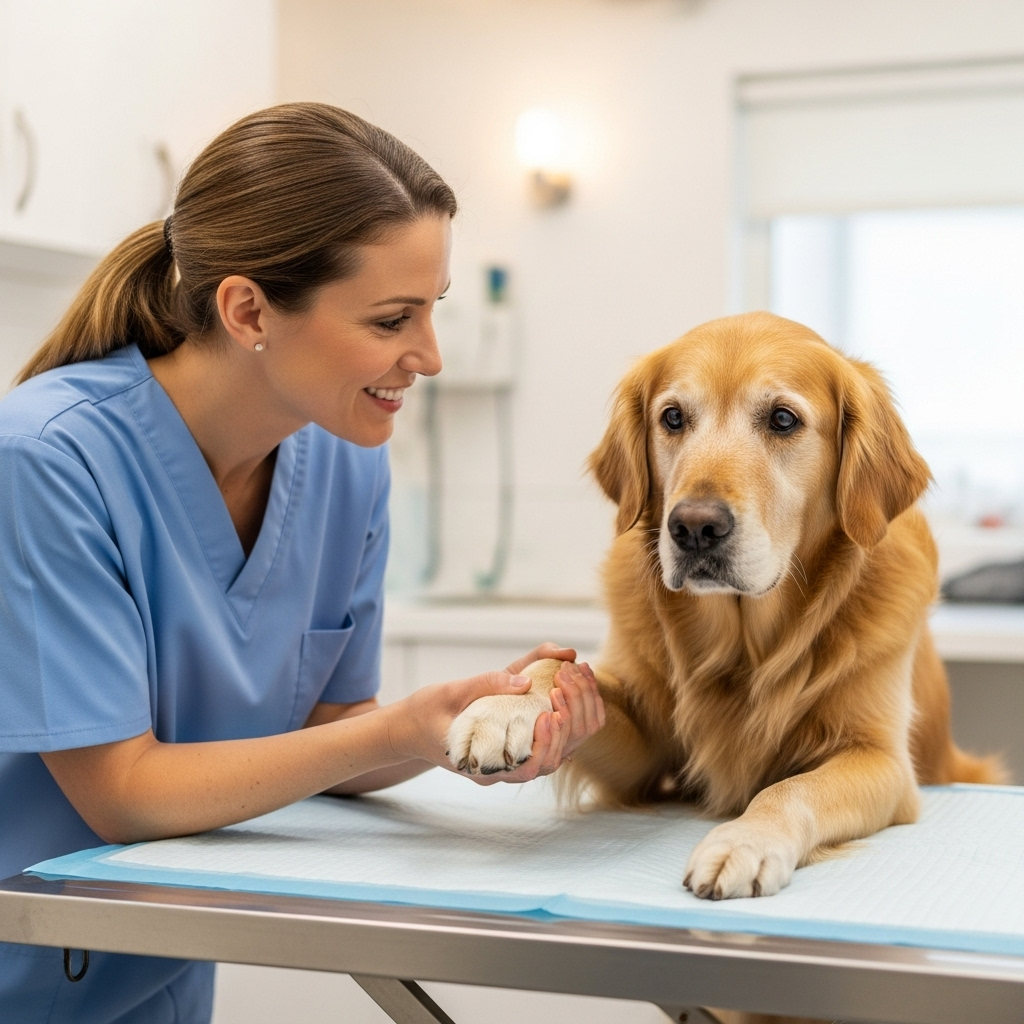
The journey to diagnose cancer in dogs doesn’t start with a high-tech scanner. It starts with you and your vet talking. I need to know everything you’ve noticed at home, subtle changes in appetite, a new lump, a slight cough, or just that they seem a bit “off.” These details are the first pieces of the puzzle.
More Than Just a Petting Session: What We’re Looking For
Next comes the physical exam, which is far more than just a friendly cuddle. It’s a systematic, nose-to-tail investigation. I’m feeling for:
- Lumps and Bumps: Checking the skin, in the mouth, and around the joints.
- Swollen Lymph Nodes: These small glands can be the first sign of trouble.
- Abdominal Changes: Gently palpating the belly to check the size and shape of organs like the spleen, liver, and kidneys.
- Unusual Sounds: Listening carefully to the heart and lungs with a stethoscope.
- Pain or Discomfort: Watching for any reaction that might indicate a sore spot.
In our clinic, a methodical approach is key. To ensure we are comprehensive, we often mentally consult foundational texts like Blackwell’s Five-Minute Veterinary Consult: Canine and Feline, which helps structure a logical diagnostic plan for any potential issue.
A Personal Story: The Subtle Clue That Saved a Patient
I once had a lovely 9-year-old Labrador named “Moose” come in for his annual vaccines. His owner said he was perfectly fine. During his exam, everything felt normal until I got to his abdomen. I felt a slight, subtle firmness in the area of his spleen that just wasn’t right. It wasn’t painful, and it was barely noticeable. Because of that small clue, we recommended an ultrasound, which revealed a tumour.
Step 1: Peeking Inside with Diagnostic Imaging
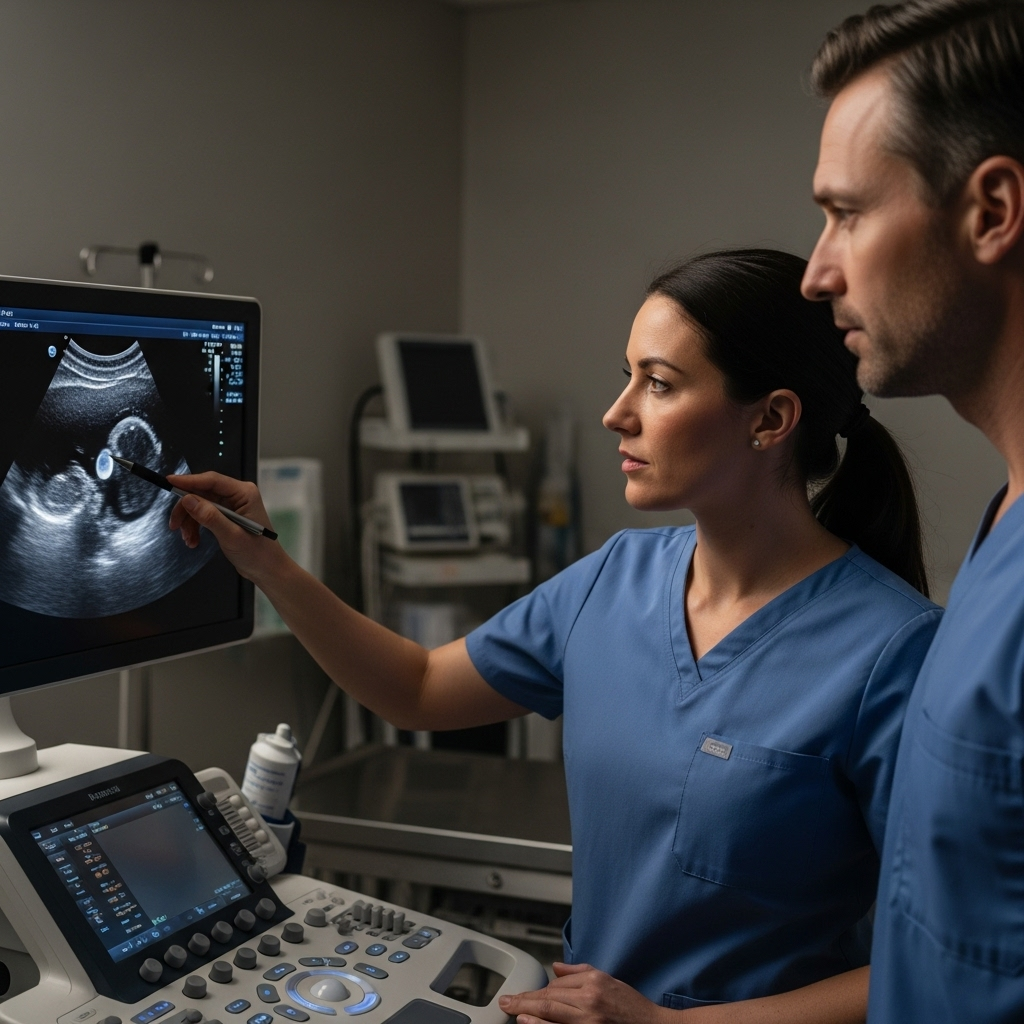
If the physical exam raises a red flag, our next step is to look inside. Imaging helps us confirm if there’s a mass, determine its location and size, and see if it’s affecting other organs.
X-Rays (Radiographs): The First Look
X-rays are often our first go-to. They are excellent for getting a broad overview of an area. We use them constantly to:
- Check the Chest: Look for tumours in the lungs or heart. This is also a key part of “staging” to see if a cancer from elsewhere has spread.
- Examine Bones: Identify bone tumours, which have a characteristic appearance on X-rays.
- View the Abdomen: See the general size and shape of organs, though details can be limited.
Ultrasound: Seeing in Real-Time
Ultrasound: Seeing in Real-Time
Think of an ultrasound as a medical sonogram. It uses sound waves to create a real-time image of soft tissues. It’s an incredibly valuable tool that allows us to see things X-rays can’t, like the internal texture of organs. With an ultrasound, we can tell the difference between a fluid-filled cyst and a solid tumour, guide a needle for a sample to help diagnose cancer in dogs, and assess blood flow to a mass.
Advanced Imaging: When CT Scans & MRIs Are Needed
For complex cases, especially in the brain, nasal passages, or for surgical planning, we may recommend a CT (Computed Tomography) scan or an MRI (Magnetic Resonance Imaging). These powerful tools are sometimes essential to accurately diagnose cancer in dogs as they provide a detailed, 3D map of the area, giving us a precise roadmap for treatment. While not every dog needs one, they are critical for certain types of cancer.
Step 2: The Definitive Answer from Biopsies and Cytology
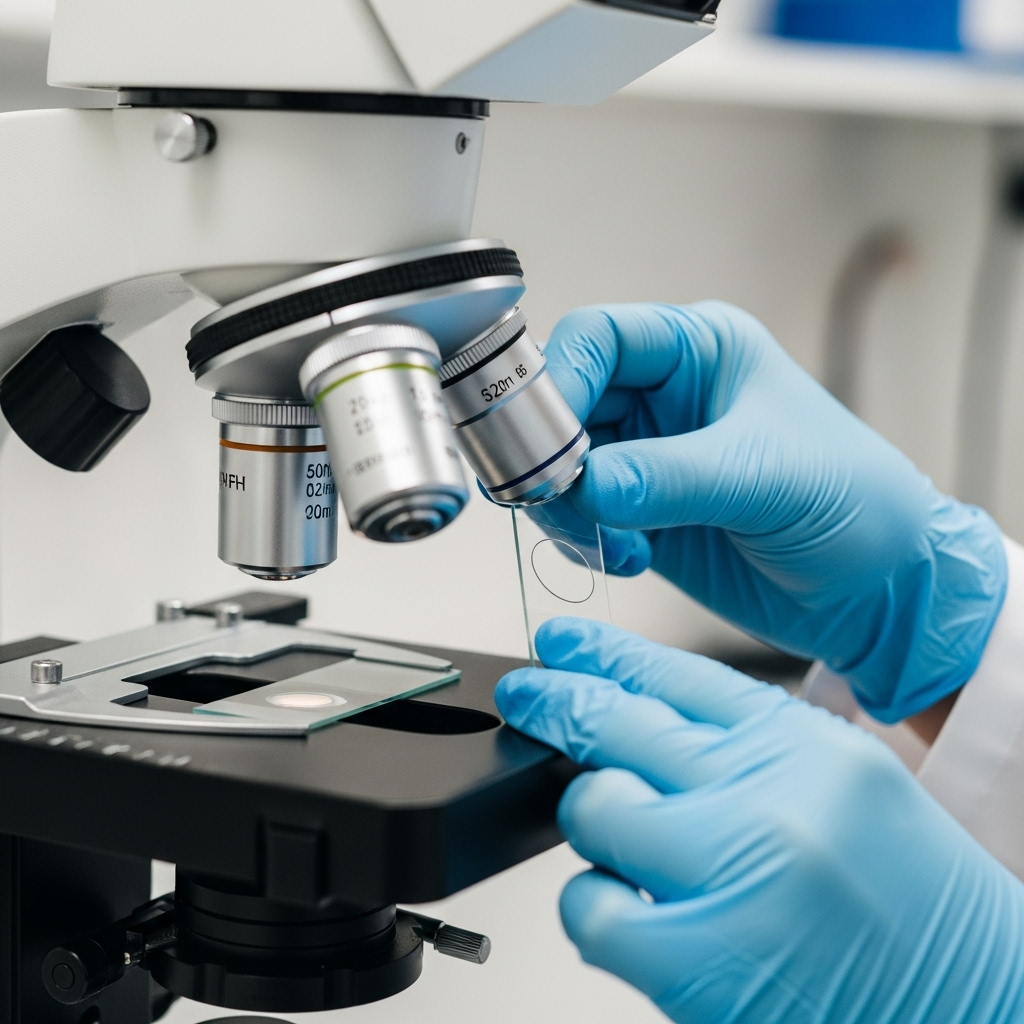
Imaging can show us that something is there, but it can’t tell us what it is. For that, we need to collect a sample of the cells or tissue. This is the single most important step to accurately diagnose cancer in dogs.
Fine-Needle Aspirate (FNA): A Quick and Minimally Invasive Test
An FNA is often our first sampling method. It involves using a very small needle (like a vaccine needle) to collect a small sample of cells from a lump or organ. In many cases, it can be done while your dog is awake and is no more uncomfortable than a blood draw. We then examine the cells under a microscope.
While fast and minimally invasive, an FNA gives us a small piece of the puzzle. The specific techniques for getting a good sample are skills we refine over the years, often referencing procedural guides like the Saunders Manual of Small Animal Practice to ensure the best possible outcome.
Biopsy: The Gold Standard for Diagnosis
The most accurate way to diagnose cancer in dogs is with a biopsy. This involves taking a small piece of tissue from the tumour, which is then sent to a veterinary pathologist for analysis. This is considered the “gold standard” because, as outlined in the Merck Veterinary Manual’s guide to diagnosing neoplasia, it allows the specialist to see not just the cells, but their structure and relationship to one another.
A biopsy tells us three critical things:
- Is it cancer?
- What type of cancer is it? (e.g., mast cell tumour, lymphoma, sarcoma)
- How aggressive is it? (The “grade” of the tumour)
This information is essential for creating an effective treatment plan.
Step 3: The Future is Now: Emerging Blood Tests (Biomarkers)
One of the most exciting developments in veterinary oncology is the rise of “liquid biopsies.” These are sophisticated blood tests that can detect tiny fragments of cancer DNA circulating in the bloodstream.
What are Liquid Biopsies?
Instead of needing a direct tissue sample from a lump, a liquid biopsy allows us to use a simple blood draw to screen for the presence of multiple types of cancer. This is a game-changer for how we diagnose cancer in dogs. This cutting-edge field is rapidly advancing, with ongoing research into canine cancer immunotherapy and biomarkers paving the way for a new era in early detection.
How These New Tests Help Us Diagnose Cancer in Dogs
These tests are becoming a powerful tool, providing new ways to approach how we diagnose cancer in dogs. They are particularly useful for:
- Early Screening: Detecting cancer in older, high-risk dogs before they even show clinical signs.
- Monitoring for Recurrence: Checking for the return of cancer with a simple blood test after a tumour has been surgically removed.
- Guiding Treatment: Helping to identify the specific genetic mutations driving a cancer’s growth, which can lead to more targeted therapies.
While they don’t yet replace the need for biopsies in most cases, they represent a major leap forward in our ability to diagnose cancer in dogs sooner and with less invasive methods.
What Happens Next? Understanding Cancer Staging

Once we diagnose cancer in a dog, the next question is: has it spread? This process is called staging.
It typically involves taking X-rays of the chest (the most common site for spread) and performing an ultrasound of the abdomen. We may also take FNA samples of nearby lymph nodes. Knowing the stage of the cancer is critical for determining the prognosis and choosing the best course of action.
At-Home Checklist: 5 Signs That Warrant a Vet Visit

You know your dog better than anyone. A monthly at-home check can help you spot potential problems early. If you notice any of the following, book an appointment with your vet.
- You know your dog better than anyone. A monthly at-home check can help you spot potential problems early, which is a critical first step for your vet to diagnose cancer in dogs as soon as possible. If you notice any of the following, book an appointment with your vet.
- New or Changing Lumps: Gently run your hands over your dog’s entire body. Feel for any new bumps, or note if existing ones have grown or changed in texture. Discovering a lump is one of the most common reasons a veterinarian begins the process to diagnose cancer in dogs.
- Unexplained Weight Loss: If your dog is losing weight despite a normal appetite, it’s a significant warning sign.
- Changes in Appetite or Thirst: A sudden refusal to eat or a dramatic increase in water consumption should be investigated.
- Lethargy or Low Energy: While all dogs slow down with age, a persistent and unusual lack of energy or unwillingness to play is a reason to call your vet.
- Persistent Cough or Trouble Breathing: Any lingering cough that doesn’t resolve in a day or two, or any signs of laboured breathing, requires immediate attention.
A Look at Your Wallet: Typical Costs to Diagnose Cancer in Dogs in Canada

These are estimates and do not include the cost of treatment.
Your Questions Answered: FAQs About Diagnosing Canine Cancer
How quickly can a vet diagnose cancer in a dog?
The timeline varies depending on the tests needed. A simple cytology result from a fine-needle aspirate might be available in 1-2 days. However, a definitive biopsy result can take 5-10 business days to come back from the lab. The complete process to diagnose cancer in dogs, including imaging and full staging, typically takes one to three weeks to gather all the necessary information.
Can blood work alone diagnose cancer in dogs?
Generally, no. Standard blood work is a crucial supportive tool that can show abnormalities suggesting cancer (like high calcium or low blood cells), but it cannot definitively diagnose cancer in dogs on its own. While emerging ‘liquid biopsy’ blood tests are becoming more common, they are not yet a universal, standalone diagnostic method and are used alongside other tests.
Is the process to diagnose cancer in dogs painful?
Veterinarians prioritise your dog’s comfort at every stage. Physical exams and X-rays are painless. A fine-needle aspirate feels like a quick needle poke, similar to a vaccine. When a surgical biopsy is required, it is always performed under sedation or general anaesthesia. We ensure the entire process to diagnose cancer in dogs is managed to be as pain-free as possible for your pet.
What is the most accurate way to diagnose cancer in dogs?
The most accurate method to diagnose cancer in dogs, known as the ‘gold standard’, is a tissue biopsy that is examined by a veterinary pathologist. This is because it provides the most detailed information, including the exact type of cancer and its grade.
A Hopeful and Empowering Conclusion
Receiving a cancer diagnosis for your dog is heavy news, but it is not the end of the story. It is the beginning of a new chapter where you become your dog’s greatest advocate. The diagnostic process we’ve discussed, from the exam table to the microscope, is all designed to give you one thing: clarity. And with clarity comes power.
The power to make informed decisions, to choose the right path forward, and to focus on the quality of life and the incredible bond you share. You are not alone in this. Your veterinary team is your partner, ready to provide expertise, support, and compassion every step of the way. Together, we can face this challenge with hope and a clear plan.

